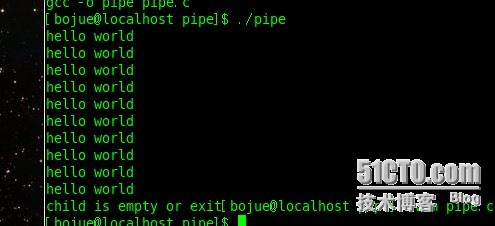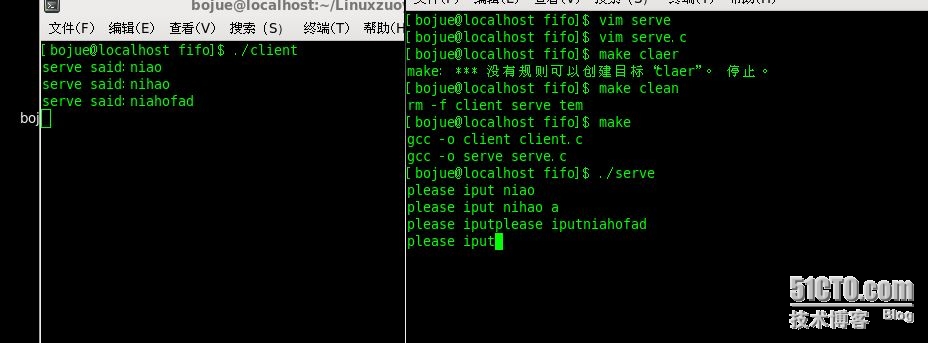Heim >Backend-Entwicklung >PHP-Tutorial >Linux – Interprozesskommunikation – Pipeline
Linux – Interprozesskommunikation – Pipeline
- 黄舟Original
- 2017-01-18 10:45:551511Durchsuche
一、进程的间通信的原理
进程间交换数据必须通过内核,在内核中开辟一块缓冲区,进程1把数据空间拷贝到内核缓冲区,进程2再从内核缓冲区把数据读走。这样就实现了进程间通信。
二、进程通信的进制--管道(pipe)
调用 pipe(int filedes[2])函数在内存中开辟的空间称为管道,它一端读数据一端写数据,通过filedes传出给用户程序的两个描述符,filedes[0]指向读端,filedes[1]指向写端。所以通过read(filedes[0);或者write(filedes),来从管道读或写文件。
三、 用管道实现进程通信的方法
(1)父进程创建管道,得到两个文件描述符指向管道的两端、
(2)父进程调用fork()创建子进程,那么子进程也有两个文件描述符指向管道的两端。
(3)父进程关闭写端,子进程关闭读端,子进程往管道写,父进程读,管道是用环形队列实现的,数据从写端写入,读端读出,这样就实现了进程通信
--代码-----
#include<stdio.h>
#include<unistd.h>
int main()
{
int _pipe[2];
int ret=pipe(_pipe);
if(ret < 0)
{
printf(" pipe()");
return 1;
}
pid_t id=fork();
if(id < 0)
{
printf("fork()");
return 2;
}
else if(id==0)
{
close(_pipe[0]);
char buf[]="hello world";
int count=10;
while(count)
{
sleep(1);
ssize_t _size=write(_pipe[1],buf,sizeof(buf));
if(_size < 0)
{
printf("write()");
return 3;
}
count--;
}
}else
{
close(_pipe[1]);
char buf[1024];
int i=0;
while(i++<10)
{
ssize_t _size=read(_pipe[0],buf,sizeof(buf));
if(_size >0)
{
buf[_size]='\n';
printf("%s\n",buf);
}
else
{
printf("child is empty or exit") ;
break;
}
}
}
return 0;
}运行结果:

四、管道的限制
两个进程用一个管道只能实现单进程通信,一个写一个读,不能同时进行读写,如果要让父进程写,子进程读,就必须重新另开一个管道。管道的读写端是通过打开的文件描述符来传递的,所以两个进程必须从父进程那里继承文件描述符。只有两个进程都能访问同一管道时,他们才能通信。
五、管道的4种特殊情况
(1)如果指向管道写端的文件描述符都关闭了,但是仍有进程从管道的读端读数据,那么管道中剩余的数据被读完后,再次read 就会返回0。
(2)如果有指向管道写端的文件描述符没关闭,而持有管道写端的进程也没有向管道中写数据,这时有进程从管道读端读数据,那么管道中剩余的数据都被读取后,再次read会阻塞,直到管道中有数据可读了才读取数据并返回。
(3)如果所有指向管道读端的文件描述符都关闭了,这时有进程向管道的写端write,那么该进程会收到信号SIGPIPE,通常会导致进程异常终止。
(4)如果所有指向管道读端的文件描述符没关闭,但是也不从管道中读取数据,这是如果进程向管道写端写数据,那么在管道被写满时,再写的话就会被阻塞,直到管道中有了空位置才写入数据并返回。
管道的缺点在于是没有名字,因此,只能用于有亲缘关系的进程之间进行通信,为了解决这个问题,又引入了命名管道(FIFO),命名管道提供了路径名与之关联,以FIFO的文件形式存储于文件系统中,所以只要访问该路劲,就能实现进程间的通信。FIFO总是按照先进先出的原则工作,第一个被写入的先出来。
一、命名管道的创建
用mkfifo函数来创建FIFO
int mkfifo(const char *path,mode_t mode);
二、命名管道的使用方法
先调用open()将其打开,要以只读的方式打开,以写的方式打开写入(O_WRONLY)
三、命名管道的程序代码:
client端
#include<stdio.h>
#include<error.h>
#include<stdlib.h>
#include<string.h>
#include<fcntl.h>
#include<sys/types.h>
#include<sys/stat.h>
#include<unistd.h>
#define _PATH_ "./.tem"
int main()
{
int fd=open(_PATH_,O_RDONLY);
if(fd<0)
{
printf("open error");
}
char buf[1024];
memset(buf,'\0',sizeof(buf));
while(1)
{
int ret =read(fd,buf,sizeof(buf));
if(ret>0)
{
buf[ret]='\n';
printf("serve said:%s\n",buf);
}
}
close(fd);
return 0;
}serve端
#include<stdio.h>
#include<stdlib.h>
#include<string.h>
#include<fcntl.h>
#include<sys/types.h>
#include<sys/stat.h>
#include<unistd.h>
#define _PATH_ "./.tem"
int main()
{
umask(0);
int ret = mkfifo(_PATH_,S_IFIFO |0666) ;
if(ret<0)
{
printf("mkfifo error\n");
return 1;
}
int fd=open(_PATH_,O_WRONLY);
if(fd<0)
{
printf("open error");
}
char buf[1024];
memset(buf,'\0',sizeof(buf));
while(1)
{
printf("please iput\n");
scanf("%s",buf);
int ret =write(fd,buf,strlen(buf)+1);
if(ret<0)
{
printf("write error\n");
break;
}
}
close(fd);
return 0;
}运行结果:

以上就是Linux --进程间通信--管道的内容,更多相关内容请关注PHP中文网(www.php.cn)!
In Verbindung stehende Artikel
Mehr sehen- So verwenden Sie cURL zum Implementieren von Get- und Post-Anfragen in PHP
- So verwenden Sie cURL zum Implementieren von Get- und Post-Anfragen in PHP
- So verwenden Sie cURL zum Implementieren von Get- und Post-Anfragen in PHP
- So verwenden Sie cURL zum Implementieren von Get- und Post-Anfragen in PHP
- Alle Ausdruckssymbole in regulären Ausdrücken (Zusammenfassung)

